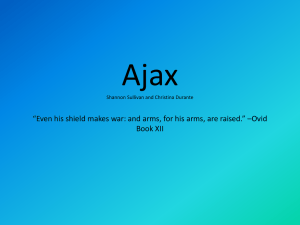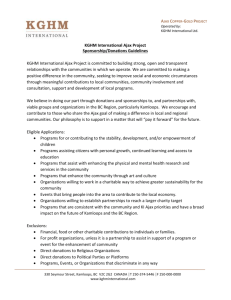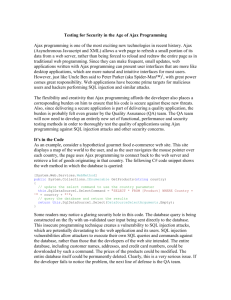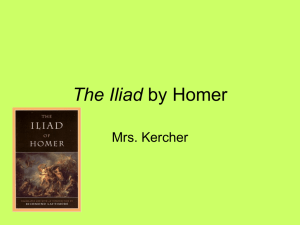Ajax - ORB
advertisement
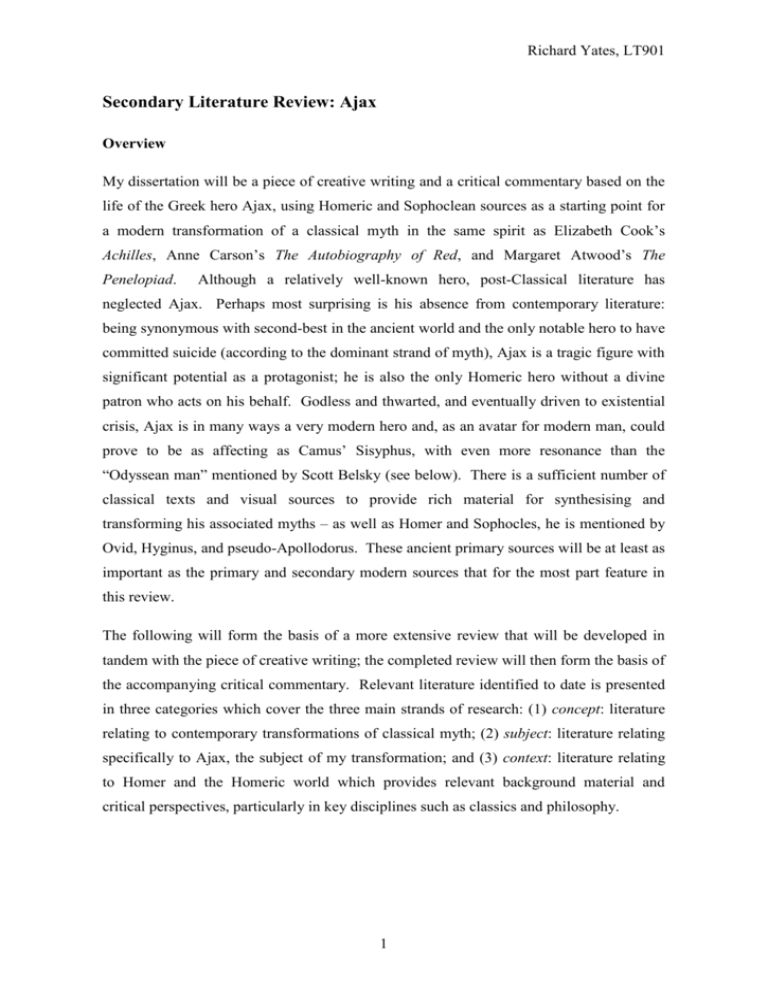
Richard Yates, LT901 Secondary Literature Review: Ajax Overview My dissertation will be a piece of creative writing and a critical commentary based on the life of the Greek hero Ajax, using Homeric and Sophoclean sources as a starting point for a modern transformation of a classical myth in the same spirit as Elizabeth Cook’s Achilles, Anne Carson’s The Autobiography of Red, and Margaret Atwood’s The Penelopiad. Although a relatively well-known hero, post-Classical literature has neglected Ajax. Perhaps most surprising is his absence from contemporary literature: being synonymous with second-best in the ancient world and the only notable hero to have committed suicide (according to the dominant strand of myth), Ajax is a tragic figure with significant potential as a protagonist; he is also the only Homeric hero without a divine patron who acts on his behalf. Godless and thwarted, and eventually driven to existential crisis, Ajax is in many ways a very modern hero and, as an avatar for modern man, could prove to be as affecting as Camus’ Sisyphus, with even more resonance than the “Odyssean man” mentioned by Scott Belsky (see below). There is a sufficient number of classical texts and visual sources to provide rich material for synthesising and transforming his associated myths – as well as Homer and Sophocles, he is mentioned by Ovid, Hyginus, and pseudo-Apollodorus. These ancient primary sources will be at least as important as the primary and secondary modern sources that for the most part feature in this review. The following will form the basis of a more extensive review that will be developed in tandem with the piece of creative writing; the completed review will then form the basis of the accompanying critical commentary. Relevant literature identified to date is presented in three categories which cover the three main strands of research: (1) concept: literature relating to contemporary transformations of classical myth; (2) subject: literature relating specifically to Ajax, the subject of my transformation; and (3) context: literature relating to Homer and the Homeric world which provides relevant background material and critical perspectives, particularly in key disciplines such as classics and philosophy. 1 Richard Yates, LT901 (1) Concept Szegedy-Maszak, Andrew, “Why do we still read Homer?”, The American Scholar, 71:1 (2002), 95-105. This paper traces the waxing and waning of popularity of the epics through recent history and engages in the debate about how modern transformations of myth should be critically received by scholars, particularly classicists. Using the engorged shades of Hades in the Odyssey as an analogy, Andrew Szegedy-Maszak argues that fictional retellings, like new works of criticism, give life-blood to the ghosts of antiquity and allow them to speak to new audiences. Rather than fixate on ‘historical inaccuracies’ (a contradiction in terms in the context of myth), classicists should recognise retellings for what they are: kindred in spirit to the epics, which are themselves variants. Retellings are recreations of old stories in a world which, although alien or exotic, is recognisable to the contemporary audience. The preference for ‘faithful’ adhesion to a ‘definitive version’, which is so typical among classicists, is a modern or post-Classical obsession with prescription and the deproliferation of information, and is in fact contrary to the spirit of the culture in which they were originally conceived. Mason, David, “Reinventing the Greeks”, The Hudson Review, 58:3 (2005), 489-498. The intended style of Ajax will be closer to early lyrical poetry than epic, therefore a closer look at the conventions and expressions of different lyrical genres will inform my stylistic approach. David Mason’s paper uses the release of Michael Schmidt’s book The First Poets as the starting point for a review of the current literature on the lives and works of the early Greek poets, including Hesiod and Homer. The paper provides a good overview and introduction to the main issues surrounding authorship and biography. It positions epic in relation to other genres of early Greek poetry (of which there were many) and explores some of the tensions “between writing and speaking, improvisation and laborious revision” (p. 490) that are still relevant today and should be taken into account in any imaginative retelling of the story of a Homeric hero. A sound understanding of the technical and thematic features of lyrical poetry will help ensure that both the narrative voice and metering of Ajax intersect with the ancient and the modern in a clear and 2 Richard Yates, LT901 purposeful way. Mason’s paper is informative and serves as an introduction to a nonspecialist reader but is otherwise limited in its usefulness. Belsky, Scott A., “The Poet Who Sings Through Us: Homer’s Influence in Contemporary Western Culture”, College Literature, 34:2 (2007), 216-228. Continuing the debate about the place of the Homeric epics in contemporary Western culture, Scott Belsky’s paper is a response to critics who argue that the appetite and pressure for diversity in literary studies has resulted in a terminal downgrading in the influence and relevance of Ancient Greece in general, and the epics in particular. Belsky argues that the relevance of the epics is not dependent on any single critical perspective and is safeguarded by their ability to absorb both praise and criticism, refracting whatever theoretical light is shone upon them. In this respect he is similar to Szegedy-Maszak. Although I share Belsky’s position, his attempt to prove the infinite depth and malleability of the epics is unconvincing and does more harm than good. He uses scenes from the Iliad and the Odyssey as evidence of the existence of proto-concepts of capitalism, colonialism, and entrepreneurship, with the ‘Odyssean man’ presented as an avatar for ‘Western man’, driven by the subjectification of the self and the need to self-promote and self-serve. Although the desire to self-serve could be considered a distinct trait of capitalist man, there is otherwise no weight to Belsky’s assertion. Particularly in economic terms, the Homeric world operates in a significantly different way to the Western world, and the examples cited simply emphasise the workings and values of a very different and unique brand of kingship. The paper would have been more convincing if the author had chosen to prove the existence of other ‘modern’ concepts that are traceable in the epics as a means to explain their continued relevance and importance. The paper does however provide further insight into the place of Homer and Homer-inspired retellings in the modern world, briefly drawing on Elizabeth Cook’s Achilles, Margaret Atwood’s Penelopiad, and Wolfgang Peterson’s film Troy (see Roisman below). 3 Richard Yates, LT901 Suzuki, Mihoko, “Rewriting the Odyssey in the Twenty-First Century”, College Literature, 34:2 (2007), 263-278. Mihoko Suzuki’s paper ‘critiques’ two recent post-feminist rewritings of the Odyssey: Margaret Atwood’s Penelopiad and Mary Zimmerman’s stage version. Suzuki provides useful insights into the aims of two prominent contemporary writers who have transformed myths to make them speak to new audiences and reflect new critical interpretations. Suzuki is apparently in support of both texts: she explores their authors’ intentions but stops short of evaluating the success or legitimacy of these, and the reader must assume that she considers these to be self-evident. Both Atwood and Zimmerman make the narrative voice female and polyphonic, and telescope the Odyssey to focus on the female cast who redress the gender balance by giving their accounts. These often take the form of a ‘palinode’ (a reversal or retraction song) which revise history and undermine traditional perceptions of events. One useful observation that Suzuki makes is that the Odyssey itself revises and critiques the Iliad, a notable example being when Achilles expresses his anger at his decision to choose a short and glorious life over a long and unremarkable one. In sum, Suzuki’s paper offers some insight into recent reimagings of Homeric myths and emphasises the dramatic and modernising potential of classical texts, but offers little else in the way of a critical perspective on either source texts or new texts. Stael, Hilde, “The Penelopiad and Weight: Contemporary Parodic and Burlesque Transformations of Classical Myths”, College Literature, 36:4 (2009), 100-118. Hilde Stael’s paper is a more detailed and theoretical critique of Margaret Atwood’s The Penelopiad and Jeanette Winterson’s Weight (a retelling of the Atlas myth). Stael compares the two texts and finds that, despite being published concurrently and written in apparent isolation, they display striking similarities in theme and narrative technique. Both use ‘postmodern metafictional parody’ (defined by Linda Hutcheon as “repetition with critical difference”, p.101) to establish their critical intentions, drawing particularly on burlesque and scatology to disrupt high and low literary genres and “neutralise ancient class distinctions” (p.107). The implication is that these transformative techniques are becoming increasingly common and may therefore be worth subverting rather than adopting. Another technique that Atwood uses which may feature in Ajax is to 4 Richard Yates, LT901 deliberately mythologise unrecorded events and demythologise recorded events, thereby inverting the literal and the figurative. Stael’s paper demonstrates how both authors use, and have to some extent pioneered, these techniques, exploring some of the devices and techniques that may work for Ajax. Stael also makes an observation that is similar in spirit to some of the other critics mentioned: Atwood’s and Winterson’s reimaginings are similar to Satyr plays which were themselves comic reworkings of tragedy, therefore the process of transformation is as old as the classical texts themselves, but what is new is the particular transformation. Roisman, Hanna M., “Helen and the Power of Erotic Love: From Homeric Contemplation to Hollywood Fantasy”, College Literature, 34:2 (2008), 127-150. Alongside Ajax and Achilles, Helen is one of the three main characters in Ajax. Hanna Roisman’s paper compares and contrasts a modern retelling of the story of Troy, Wolfgang Peterson’s 2004 film Troy, with the Iliad. The paper is therefore interesting as it deals with ‘subject’ and ‘concept’ as well as providing ‘context’. The main problem with Roisman’s paper is that she mistakes Troy for a retelling of the Iliad instead of either a transformation of the Iliad or a retelling of the Troy story in general. This serves as a warning and demonstrates the single-minded conservatism of some scholars, particularly classicists, in relation to modern versions of classical texts. “There is no trace in Troy of at least three of the six scenes through which the Iliad show’s Helen’s personality and predicament,” Roisman observes disapprovingly (p.128) – but this should come as no surprise because Troy does not claim to be a version of the Iliad. Roisman explores the different ways Helen has been characterised, which presents interesting possibilities for my own characterisation, but is bent on proving the superiority of the Iliad’s Helen to Troy’s, a “wisp of a film” (p.128). However, Roisman admits that Helen is only a “minor character” in Troy (p.128) and, in doing so, undermines the fairness and legitimacy of a comparison with the Iliad. She then reduces the two representations of love, seen as the main characterising force behind Helen, to Imperfect and Realistic (Homer) versus Perfect and Unrealistic (Peterson), the latter apparently following typical Hollywood fantasy style. But this is premised on the author’s own conception of love as inevitably fading over time. Finally, Roisman claims that Troy “attempts to gain sympathy for Helen by legitimising her elopement and denying its consequences” (p.137) – that is, by presenting war as 5 Richard Yates, LT901 inevitable and driven by imperialism. She confuses cause and effect: given her own admission that Helen is a minor character, it seems unlikely that Peterson would base the characterisation of war around the peripheral Helen instead of the other way around. In sum, the paper is biased and flawed, but offers a detailed discussion of Helen in a number of modern cinematic sources. (2) Subject Duffy, William, “Aias and the Gods”, College Literature, 35:4 (2008), 75-96. This paper focuses on Ajax and his relationship with the gods in the Iliad. Ajax has two signature traits: he is the second best soldier in the Greek army and he alone receives no divine favour, whereas other notable heroes such as Achilles and Odysseus have divine patrons who intervene on their behalf. William Duffy uses “extra-Iliadic” sources to illuminate Homeric relationships and concludes that, contrary to the consensus among classicists, Zeus has a significant emotional attachment to Ajax and demonstrably acts on his behalf on occasions when it does not compromise his divine plan, the survival of Troy. Hector in particular is Zeus’ favourite, and when Hector is brought into the equation, the true nature of the Ajax/Zeus interactions is revealed. Although Duffy provides convincing textual evidence to support his theory, he overlooks the possibility that the Zeus/Hector/Ajax dynamic serves to emphasise Ajax’s other signature trait: even in his relationships with the gods – which are typically intimate and reciprocal – Ajax is second best. As well as providing excellent close-text analysis of the way Ajax relates to the rest of the Homeric cast, Duffy’s paper is rare (especially in Literature Online) in that its primary focus is on Ajax, and to this end provides a valuable bibliography. Moore, Mary B., “Exekias and Telamonian Ajax”, American Journal of Archaeology, 84:4 (1980), 417-434. Mary Moore’s paper provides a useful discussion of the depictions of Ajax by the potter and painter Exekias, exploring key scenes that will feature in my own writing, including his suicide. The focus of the paper is twofold: (i) to prove Exekias’ special interest in 6 Richard Yates, LT901 Ajax (the hero features more than any other in the painter’s known output, which is considerable, yet is otherwise barely represented at all in Attic vase painting), and (ii) to suggest the reason for his interest. Moore’s answer to the latter is underwhelming: Exekias was probably from Salamis, which was traditionally thought to be the home of Ajax. Moore does not attempt anything beyond this; she does not, for example, identify anything of Exekias’ life or extrapolate aspects of his personality from his unique treatment of Ajax when exploring his stylistic and thematic fixations. She does however succeed in proving Exekias’ special interest in Ajax above and beyond the regularity of his appearances on surviving pottery (which may be unrepresentative of his total output) through some shrewd analysis. As well as illuminating scenes from Homer and Sophocles, Exekias’ treatment provides new source material about the myths surrounding Ajax. In summary, although the argument that structures the paper is disappointing and underdeveloped (at best Moore’s speculations bookend the paper), the ekphrasis is good and the analysis of the visual legacy of Ajax is comprehensive. Shapiro, H. A., “Exekias, Ajax, and Salamis”, American Journal of Archaeology, 85:2 (1981), 173-175. As a rejoinder to Mary Moore’s paper, H. A. Shapiro offers some alternative explanations for Exekias’ special interest in Ajax, although he does not deny the possibility that he was a Salaminian who enjoyed celebrating the heroics of a fellow local. Shapiro focuses more on the historical context: Salamis is positioned in the Saronic Gulf between the two major powers of Athens and Megara; throughout its history, from the Archaic period onwards, it has changed hands and been the subject of legitimising propaganda. With this in mind, Shapiro offers two main alternatives to the Salamis-as-homeland theory: (i) Ajax was the subject of a vase-based campaign to advertise Attic claims to Salamis; and (ii) there were alleged descendants of Ajax living in Athens in the sixth century, the Philaidai, who had a particular interest in the annexation of Salamis and may have been patrons-of-the arts to Exekias. Shapiro’s paper is short but well argued and is interesting both from a purely academic perspective and because it explores the way that the meanings and cultural values associated with Ajax have changed over time. 7 Richard Yates, LT901 (3) Context Weil, Simone, “The Iliad, or The Poem of Force” in War and the Iliad, with Rachel Bespaloff, trans. Mary McCarthy (New York: New York Review Books, 2005) Simone Weil’s seminal essay argues that the Iliad is best read as a poem about force. According to Weil, every person has the power to exert force and modify the behaviour of another person, force being defined as the power by which X turns Y into a ‘thing’. The result can be death, but worse than this is being transformed into a thing whilst still alive – a thing with a soul but without the power to exert its own force. The enduring appeal of the Iliad lies in the exploration of these extremes of force, as well as the balance and objectivity of the narrative: all men are its victims, even Achilles; all men vacillate between pure passivity (‘inert matter’) and pure momentum (‘blind force’). Written in a hurried style that reflects both the importance of what is at stake in the Iliad and the imminence of the Second World War, Weil concludes that force cannot be eradicated, but that the unique spiritual force of the Greeks, which enabled them to avoid self-deception and identify with both conqueror and conquered, can serve as a lesson to the Western world. Any creative retelling of the Iliad should in some way respond to Weil’s essay, and consider the nature of the continued relevance of the world of the Homeric heroes. 8

